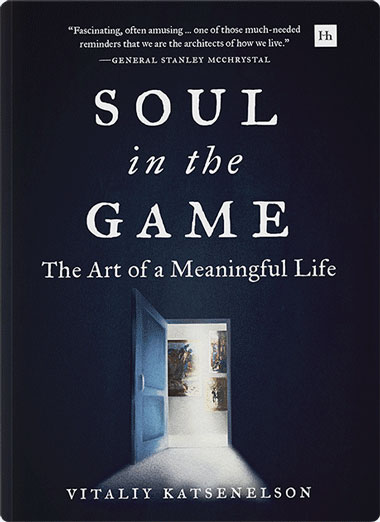“Fascinating, often amusing… one of those much-needed reminders that we are the architects of how we live.”
General Stanley McChrystal
Author, Risk, A User’s Guide
I have always had a difficult relationship with Tchaikovsky’s music. My parents loved his first piano concerto, and I’ve listened to it several hundred times over the years (I love it, too). At the same time, I was forced to listen to his music at school in Russia. Anytime I am forced into something, I naturally start resenting it. This applies to Russian literature as well: My teachers turned Russian literature into Mark Twain’s definition of “classics”: books that people praise and don’t read. I am still trying to get back into Russian literature.
Tchaikovsky’s music has been overpopularized in America. The Nutcracker has turned into a Christmas ballet, which is so popular that for some ballet companies it accounts for almost half of their annual revenues. The 1812 Overture,
which was written as a celebration of a Russian victory against Napoleon, has been turned into a theme song for America’s independence from… the British. Swan Lake, though it has not yet been fully Americanized, still has a good chance of becoming an American Thanksgiving ballet.
Luckily, as I have grown older, Tchaikovsky’s incredible music has overcome my implanted childhood resentment, even if it took time.
Tchaikovsky (1840–1893) was a master of emotions. He was a neurotic, highly sensitive person, full of phobias. For instance, he had a phobia that his head would fall off when he was conducting. (He eventually overcame this phobia, since at times he had to earn a living as a conductor.) His music is ridden with emotions; it is the manifestation of his emotions. It is his emotional confession.
There are several theories as to why Tchaikovsky died at age 53. The theory I heard when I was a child in Russia was that he died from cholera, probably as a result of drinking contaminated water. However, there is another theory about his death: that he committed suicide.
Tchaikovsky is a Russian national treasure, a symbol of Russian greatness, someone the propaganda machine could point at and say, “Materialistic Americans have their poisonous hamburgers (and a chicken in every pot, and toilet paper, and…), but we got art.” This is also why the propaganda machine would censor a little-known fact about its hero: Tchaikovsky was gay.
Russian homophobia goes back centuries, as it does in most places in the world. And in the late 19th century, Tchaikovsky’s era, it was in full flight. Therefore, Tchaikovsky hid his sexuality his whole life.
Many think the cholera story was a cover-up. Tchaikovsky was caught having an affair with Duke Stenbock-Thurmor’s nephew. The duke was going to write a letter of protest to the Czar. This would likely have brought disgrace to Tchaikovsky. A “court of honor” made up of his former classmates in Saint Petersburg ordered Tchaikovsky to swallow poison. He did. Or so the story goes.
We’ll never know which theory is true, the cholera or the suicide, but we do know that Tchaikovsky’s sexuality had an impact on his music.
Tchaikovsky’s Symphony No. 6, called Pathetique (which translates from Russian as “passionate”), was Tchaikovsky’s final symphony. He conducted its premiere just nine days before his death in 1893.
To understand this symphony, we have to understand the dark period in Tchaikovsky’s life. Tchaikovsky wrote Pathetique when he was depressed and doubting his ability to compose. (He had destroyed his previous symphony because he was unsatisfied with it.)
There is an argument that Pathetique is Tchaikovsky’s suicide note. Historians and music critics are divided on this point. They don’t know, and we will probably never know, the truth; but I would like to zoom in on the fourth movement of this symphony in order to let the music help you decide.
The first three movements are gloriously optimistic: there is a waltz; beautiful, lingering melodies; and ballet dances. You don’t need much imagination to see a sunrise, vast Russian landscapes, troikas, and bright white snowfields (Doctor Zhivago-style).
The fourth movement is different. It starts with a cry for help (voiced with the violins). It builds on melancholic, depressive overtones. Tchaikovsky masterfully borrows melodic elements from the first three movements, but these melodies are barely recognizable, as they are painted over with deep sadness. And unlike Tchaikovsky’s other pieces that arrive at a natural finale (you can feel they are about to end), this symphony (like death) ends in nothingness, absolute nothingness – the music just fades out.
There is a great lesson that we all can learn from Tchaikovsky’s Piano Concerto No. 1. It was common at the time to dedicate a piece of music to the musician whom you wanted to perform the music, usually a famous performer. Dedication ensured that a piece of music would see the light of day and also provided an endorsement of the piece.
Tchaikovsky dedicated his first piano concerto to Nikolai Rubenstein. Nikolai was considered to be one of the greatest pianists of his time, and he and his brother Anton Rubenstein were important figures in Russian musical culture. In fact, Anton was Tchaikovsky’s composition teacher.
Excited, Tchaikovsky played the concerto for Nikolai, who listened in silence and then told Tchaikovsky what he thought of it. Here is what Tchaikovsky wrote about this scene to his pen pal Nadezhda Von Meck:
It turned out that my concerto was worthless and unplayable; passages were so fragmented, so clumsy, so badly written that they were beyond rescue; the work itself was bad, vulgar; in places I had stolen from other composers; only two or three pages were worth preserving; the rest must be thrown away or completely rewritten. “Here, for instance, this – now what’s all that?” (he caricatured my music on the piano) “And this? How can anyone…” etc., etc.
Just imagine that someone you respect and admire, who has incredible influence, just called two years of your work “pathetic.”
Tchaikovsky was genuinely hurt, but he pledged that he would not change a single note. He reached out to a famous German pianist and conductor, Hans von Bulow, and asked if he could dedicate the concerto to him. At the time, Von Bulow was preparing to go on tour to the United States. He loved the concerto! And thus Tchaikovsky’s First was first performed in Boston in 1875. It was a great success. Music critics still found a lot of faults in it. It did not fit the established framework: The introduction, the part that makes this concerto so grand, is almost a self-contained piece of music that is attached to the concerto.
Here is the punchline. Later that year, a few months after the Boston performance, the concerto premiered in Saint Petersburg and then in Moscow. Nikolai Rubenstein conducted the Moscow premiere. Rubenstein performed the piano solo many times and even asked to premiere Tchaikovsky’s second piano concerto. Tchaikovsky would have consented if Rubenstein had not died.
Tchaikovsky’s Violin Concerto in D major suffered a similar fate, except that it was rejected not just by one, but by two performers. Parts of it were difficult to play. Critics did not like this concerto, either. One called it “long and pretentious,” and that critic continued, “The violin is not played but beaten black and blue.” Just like Tchaikovsky’s piano concerto, this violin concerto became a tremendous success and is now among the most beloved violin concertos.

Dubbed “the new Benjamin Graham” by Forbes, Vitaliy is the CEO of a value investing firm, author of several books, and a prolific writer on topics as diverse as investing, parenting, classical music, and self-improvement. You can read his articles at Investor.fm or listen to them on his podcast, The Intellectual Investor.
“Fascinating, often amusing… one of those much-needed reminders that we are the architects of how we live.”
General Stanley McChrystal
Author, Risk, A User’s Guide
“Soul in the Game is a beautiful way to search for the lost value of happiness, strength and health.”
Wim Hof
Author, The Wim Hof Method

“Vitaliy knows how to tell a story. This book reads like a conversation with Vitaliy: deep, insightful, inquisitive and civilized.”
Nassim Nicholas Taleb
Author, The Black Swan
“Vitaliy Katsenelson has been singled out by financial media for his brilliant investment strategies, but perhaps even more impressive are his philosophical writings.”
Carl Bernstein
Author, All the Presidents Man
Leave a review and send a link or a screenshot of the review to bonus@soulinthegame.net to receive 6 new pieces (35 pages of content!)